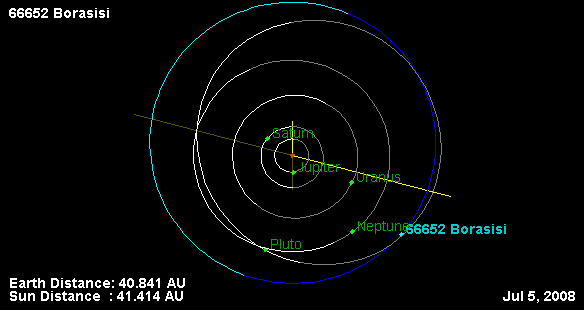Discovery date 8 September 1999 Observation arc 4790 days (13.11 yr) Discovered 8 September 1999 Argument of perihelion 194.98° Discovery site Mauna Kea Observatories | MPC designation (66652) 1999 RZ253 Aphelion 47.291 AU (7.0746 Tm) Inclination 0.56319° | |
 | ||
Discovered by A. Trujillo, J. Luu and D. Jewitt Minor planet category trans-Neptunian objectcubewanoSCATNEAR Similar Chad Trujillo discoveries, Other celestial objects | ||
66652 Borasisi /ˌbɒrəˈsiːsi/ is a binary classical Kuiper belt object. It was discovered in 1999 by Chad Trujillo, Jane X. Luu and David C. Jewitt and identified as a binary in 2003 by K. Noll and colleagues using the Hubble Telescope.
Contents
Satellite
In 2003 it was discovered that 66652 Borasisi is a binary with the components of comparable size (about 100–130 km) orbiting the barycentre on a moderately elliptical orbit. The total system mass is about 3.4 × 1018 kg.
The companion (66652) Borasisi I, named Pabu /ˈpɑːbuː/ orbits its primary in 46.2888 ± 0.0018 days on an orbit with semi-major axis of 4528 ± 12 km and eccentricity 0.4700 ± 0.0018. The orbit is inclined with respect to the observer by about 54° meaning that is about 35° from the pole-on position.
Physical properties
The surface of both components of the Borasisi–Pabu system is very red.
Naming
Borasisi is named after a fictional creation deity taken from the novel Cat's Cradle by Kurt Vonnegut. In the book, Borasisi is the Sun and Pabu is the name of the Moon:
Borasisi, the sun, held Pabu, the moon, in his arms and hoped that Pabu would bear him a fiery child. But poor Pabu gave birth to children that were cold, that did not burn... Then poor Pabu herself was cast away, and she went to live with her favorite child, which was Earth.Exploration
Around 2005, Borasisi was considered as a target for the proposed New Horizons 2 after a Triton/Neptune flyby.
